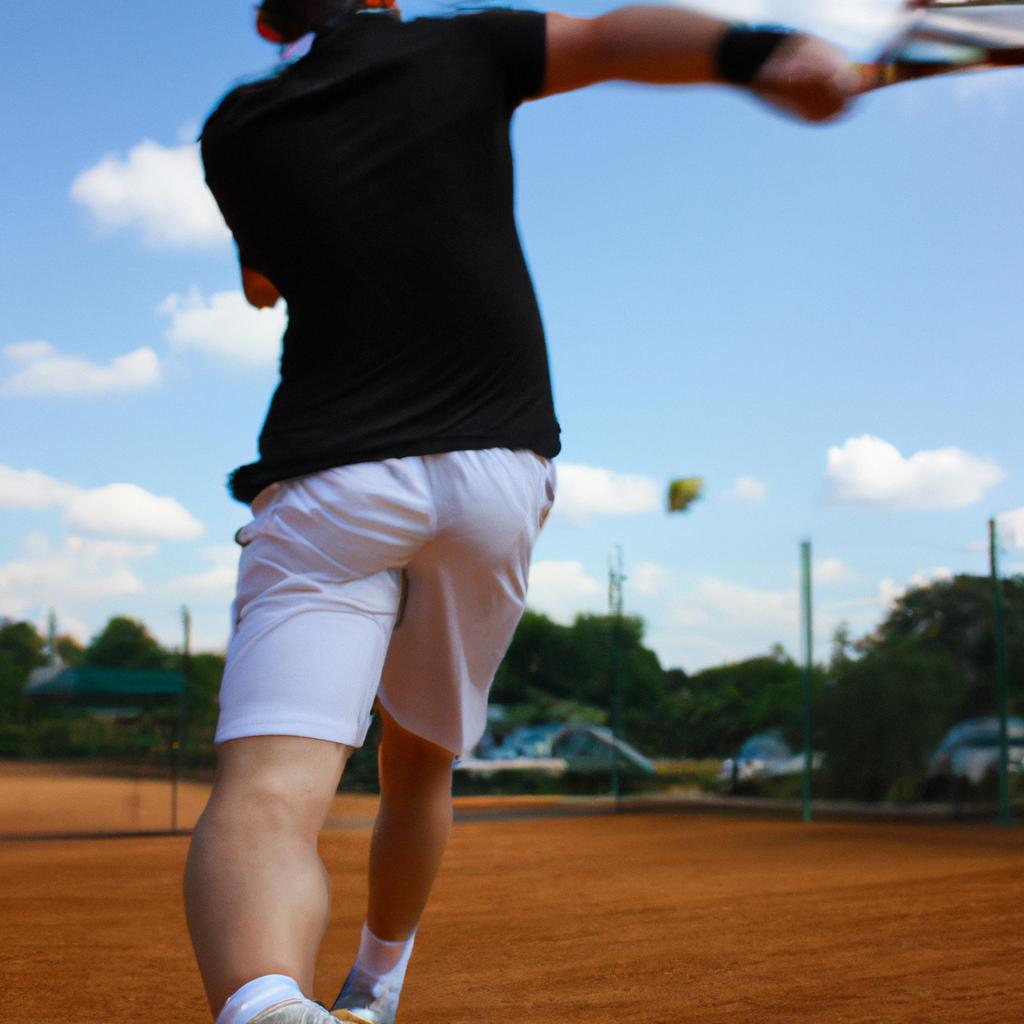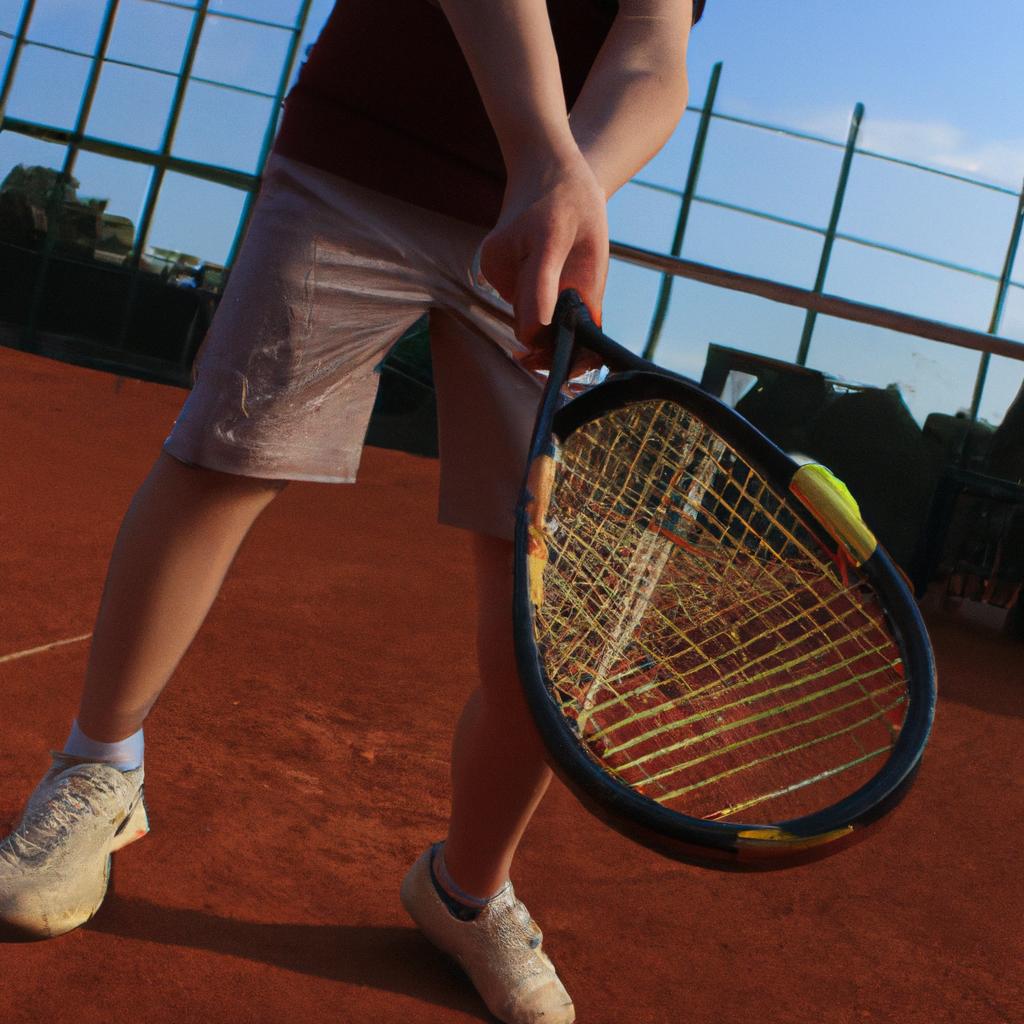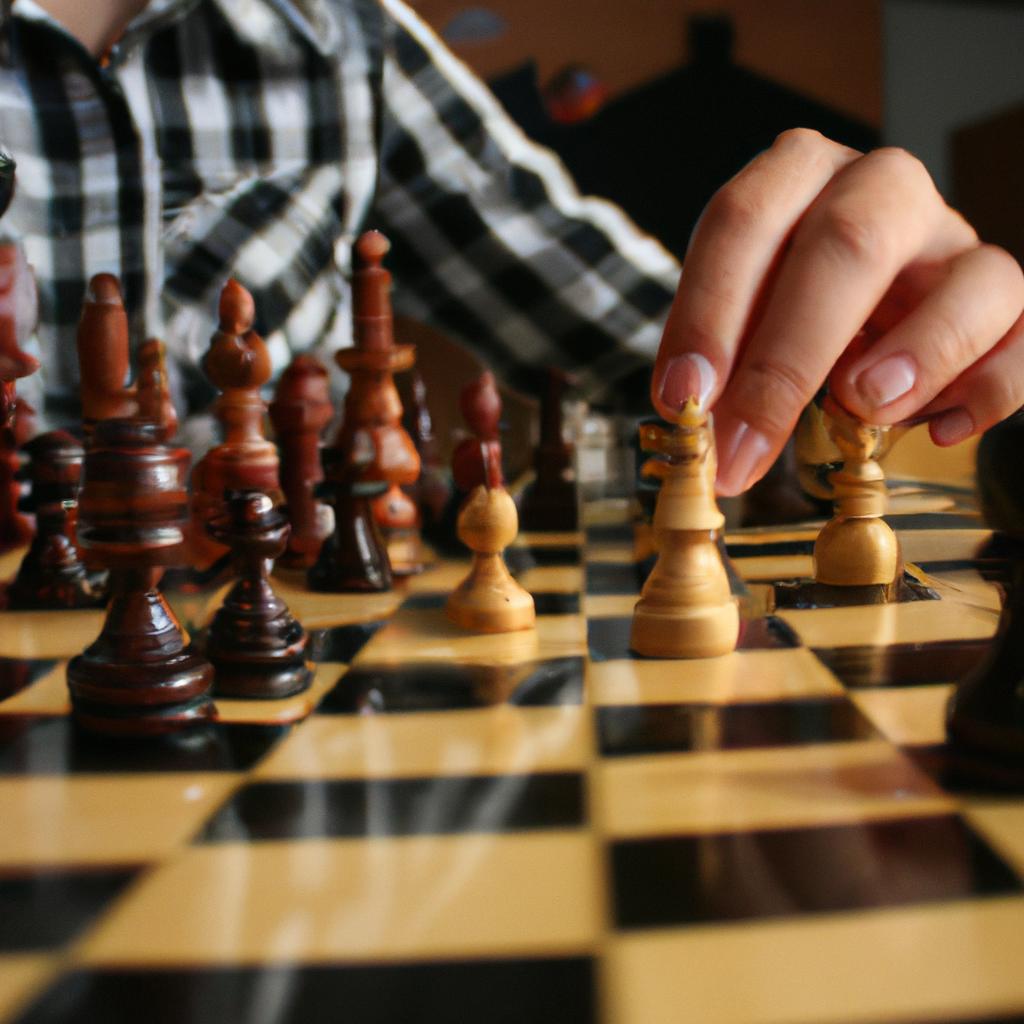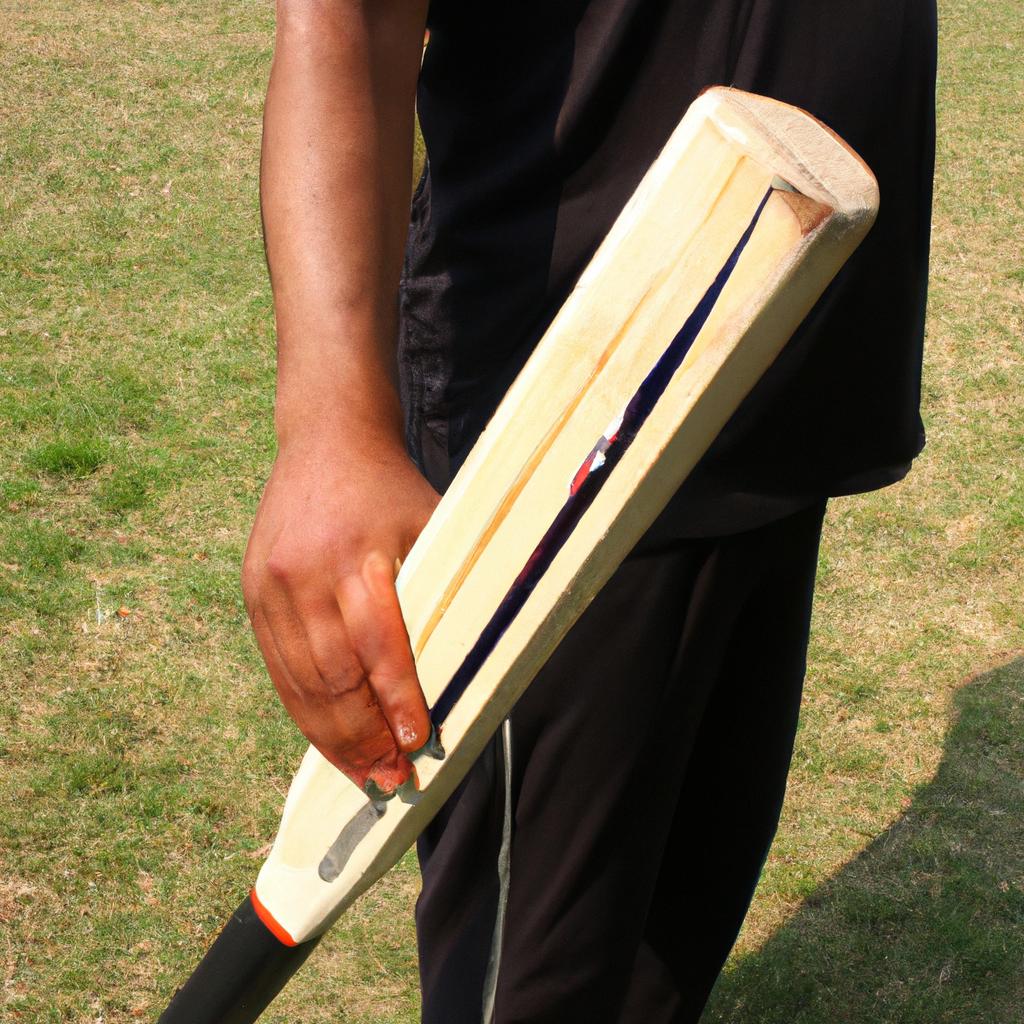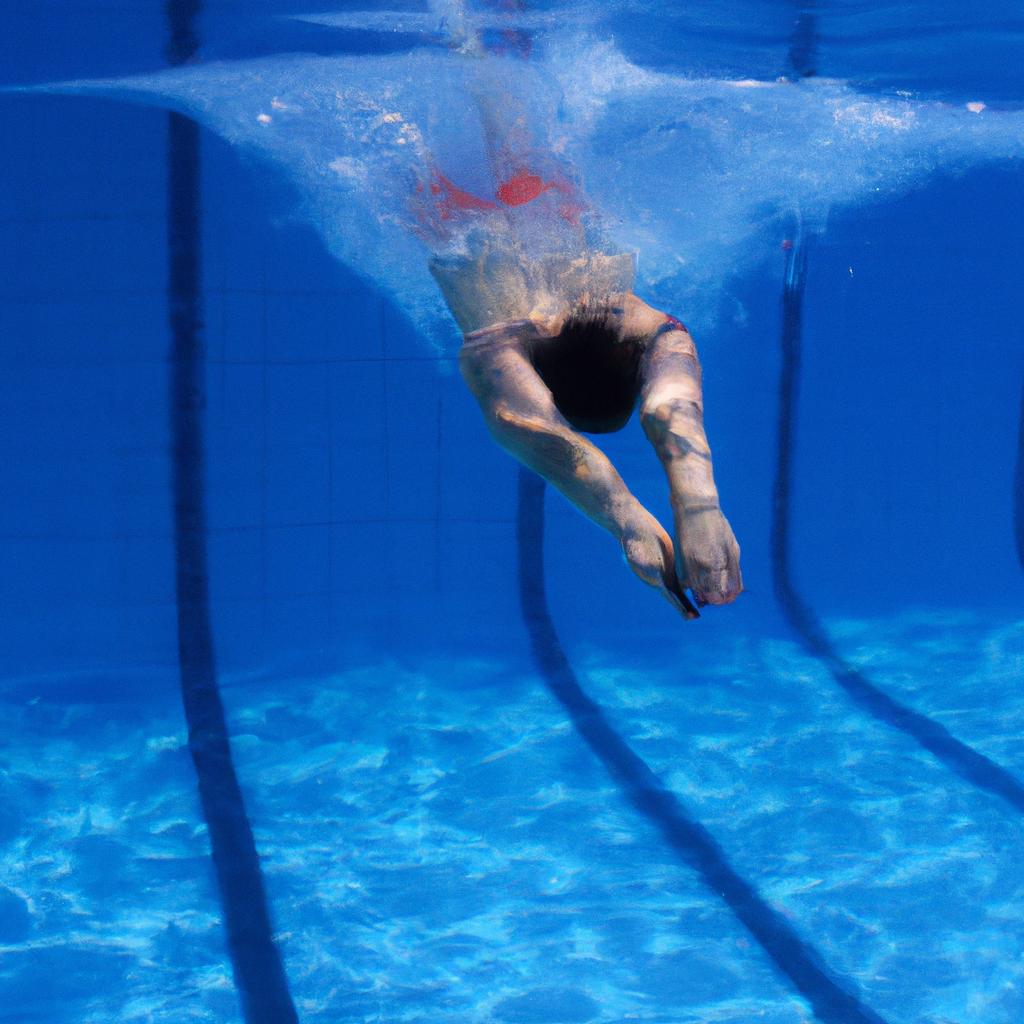The sport of tennis has long been recognized as a game that requires not only physical skill and agility but also strategic thinking and tactical decision-making. In order to excel in this highly competitive sport, players must possess the ability to adapt their strategies and change their tactics based on various factors such as opponent’s playing style, court conditions, and match situations. This article explores the concept of “Game Change” in tennis, wherein players strategically alter their approach mid-match to gain an advantage over their opponents.
To illustrate the significance of game change in tennis, let us consider a hypothetical scenario. Imagine two professional tennis players engaged in a grueling five-set match during a Grand Slam tournament. Both players are evenly matched with similar skills and styles of play. However, midway through the fourth set, Player A recognizes that his opponent is struggling with high balls to his backhand side. Sensing an opportunity for success, Player A decides to employ a new tactic – hitting deep topspin shots consistently towards his opponent’s weaker backhand wing. As a result, Player B becomes increasingly uncomfortable and starts making unforced errors due to the pressure imposed by this sudden change in strategy from Player A.
In essence, mastering tennis goes beyond mere technical proficiency; it involves understanding when and how to adapt and change one’s game plan. This ability to recognize weaknesses or patterns in an opponent’s game and exploit them through strategic adjustments is what separates the great players from the good ones.
Game change in tennis can take many forms. It could involve altering shot selection, changing the pace of play, varying the placement and depth of shots, or even modifying one’s own positioning on the court. These changes are made not only to exploit an opponent’s weaknesses but also to disrupt their rhythm and force them out of their comfort zone.
Another crucial aspect of game change is the mental aspect. Tennis is a mentally demanding sport, and being able to adapt one’s mindset during a match is just as important as making physical adjustments. Players must stay focused, remain calm under pressure, and have confidence in their ability to execute new strategies effectively.
It is worth noting that game change is not limited to individual matches but can also occur over a player’s career. As opponents become more familiar with a player’s style of play, it becomes necessary for that player to continually evolve and develop new skills to stay competitive at the highest level.
In conclusion, game change is an essential component of success in tennis. The ability to adapt strategies and tactics mid-match based on various factors can provide players with a significant advantage over their opponents. By recognizing weaknesses, exploiting them strategically, and staying mentally strong, players can elevate their performance and achieve greater success on the court.
Understanding the Difference Between Strategy and Tactics in Tennis
To truly excel at tennis, it is essential to understand the distinction between strategy and tactics. While these terms are often used interchangeably, they refer to different aspects of the game that play a crucial role in determining success on the court.
Let’s consider an example to illustrate this concept: imagine a hypothetical scenario where two players with equal skill levels face each other in a match. Player A has a powerful serve and prefers to rely on their aggressive groundstrokes to overpower opponents. On the other hand, Player B excels at returning serves and employs a defensive playing style. In this case, Player A’s overall approach can be seen as their strategy – relying on their strengths to dominate rallies and dictate play. Meanwhile, Player B’s ability to anticipate shots and return them effectively represents their tactical acumen – using specific techniques or skills during individual points.
It is important for players to recognize that effective strategies lay the foundation for successful execution of tactics during matches. Some key differences between strategy and tactics include:
- Scope: Strategy encompasses overarching plans or approaches designed to achieve long-term goals, while tactics focus on immediate actions taken during individual points.
- Adaptability: Strategies are generally more stable and less prone to change throughout a match, whereas tactics require constant adaptation based on evolving circumstances.
- Influence: Strategic decisions impact multiple aspects of gameplay beyond just shot selection, such as positioning on the court or mental mindset. Tactical choices primarily revolve around shot selection and placement.
- Timeframe: Strategies are typically established before a match begins or during practice sessions, whereas tactics are implemented dynamically during live play.
By understanding these distinctions, players can develop comprehensive game plans that incorporate both strategic considerations and tactical adaptations. This holistic approach enhances performance by leveraging one’s strengths against an opponent’s weaknesses while remaining adaptable to changing situations on the court.
In transitioning towards our next section about “Analyzing Your Opponent’s Strengths and Weaknesses,” it is crucial to recognize that strategy and tactics are closely intertwined. By analyzing an opponent’s game, players can identify strategic opportunities that align with their own playing style while also formulating tactical adjustments to exploit weaknesses. This process allows for a more effective utilization of strategies in real-time scenarios, increasing the chances of success on the tennis court.
Analyzing Your Opponent’s Strengths and Weaknesses
Transitioning from our understanding of the difference between strategy and tactics in tennis, let us now delve into the crucial process of analyzing your opponent’s strengths and weaknesses. To illustrate its significance, we will consider a hypothetical scenario involving two professional players competing against each other.
Imagine Player A, known for their powerful serves and aggressive baseline shots, going up against Player B, who excels at defensive play and has exceptional footwork. In this matchup, it becomes imperative for both players to analyze their opponent’s strengths and weaknesses accurately.
Analyzing an opponent’s strengths and weaknesses allows you to tailor your game plan accordingly. Here are some key steps to effectively assess your adversary:
- Determine their preferred playing style: Recognize whether they prefer aggressive or defensive play, as this will assist in anticipating their strategies.
- Identify their technical proficiency: Assess their skills by examining areas such as serve quality, backhand technique, volley accuracy, or movement on the court.
- Observe patterns and tendencies: Pay attention to any recurring shot choices or strategic decisions that your opponent frequently utilizes during matches.
- Evaluate mental resilience: Consider how well they handle pressure situations or react when faced with unexpected challenges.
To demonstrate these steps further, refer to the table below showcasing a comparison between Player A (Aggressive Baseline) and Player B (Defensive Specialist):
| Aspect | Player A | Player B |
|---|---|---|
| Playing Style | Aggressive | Defensive |
| Serve Quality | Powerful | Consistent |
| Backhand Technique | Strong | Reliable |
| Volley Accuracy | Average | Exceptional |
| Movement on Court | Quick | Agile |
Through careful analysis like this example above, you can gain valuable insights into your opponent’s capabilities. Armed with this knowledge, you can then strategize and adapt your game plan to exploit their weaknesses while capitalizing on their strengths.
Transitioning into the subsequent section about “Adapting Your Game Plan to Different Court Surfaces,” this analysis of an opponent’s strengths and weaknesses provides a solid foundation for developing effective strategies that align with specific court conditions.
Adapting Your Game Plan to Different Court Surfaces
Section Transition: Having gained a thorough understanding of your opponent’s strengths and weaknesses, you are now ready to adapt your game plan to different court surfaces. By tailoring your strategies according to the unique characteristics of each surface, you can maximize your chances of success on any given match day.
To illustrate the importance of adapting your game plan to different court surfaces, let’s consider the case study of two professional tennis players – Player A and Player B. Player A excels on clay courts due to their exceptional footwork and ability to generate heavy topspin shots. In contrast, Player B thrives on fast indoor hard courts where their powerful serve and aggressive baseline play make them a formidable opponent.
When playing on clay courts:
- Utilize deep groundstrokes with heavy spin to exploit the slower bounce.
- Focus on long rallies that test your opponent’s endurance and consistency.
- Look for opportunities to hit drop shots or use angles to disrupt your opponent’s movement.
- Maintain patience and resilience as matches on clay often require more time and effort.
On fast indoor hard courts:
- Capitalize on your strong serves by aiming for precise placement rather than sheer power alone.
- Play aggressively from the baseline, looking for short balls to attack and finish points quickly.
- Adapt quickly during rallies by adjusting footwork and shot selection based on the pace of the ball.
- Maintain mental composure even when facing intense pressure, as quick exchanges demand swift decision-making.
Table Example:
| Surface | Characteristics | Recommended Strategies |
|---|---|---|
| Clay | Slower bounce, favors consistent baseliners | Deep groundstrokes with spin |
| Fast Indoor Hard | Quick pace, rewards aggressive play | Precise serving and attacking from the baseline |
By acknowledging these differences in court surfaces and employing the strategies outlined above, you can optimize your performance and increase your chances of victory. The ability to adapt demonstrates not only tactical versatility but also a deep understanding of the game.
As you develop your skills in adapting to different court surfaces, it is equally vital to focus on developing a consistent serve and return strategy.
Developing a Consistent Serve and Return Strategy
Imagine you are a professional tennis player preparing for a crucial match in a Grand Slam tournament. As you step onto the court, you notice that it is not the familiar hardcourt surface you have been practicing on for months, but rather a clay court. Suddenly, your game plan needs to adapt to suit this different playing environment. Adapting your strategies and tactics to various court surfaces is essential in order to maximize your chances of success.
When facing different court surfaces, players must consider several factors that can significantly impact their gameplay. Here are some key points to keep in mind:
-
Surface Characteristics: Each type of court has unique characteristics that affect ball speed, bounce height, and movement patterns. For instance, clay courts are slower due to increased friction between the shoe sole and surface, resulting in higher bounces and longer rallies. On the other hand, grass courts offer faster play with lower bounces. Understanding these variations allows players to adjust their shot selection and timing accordingly.
-
Footwork Adaptation: The ability to quickly adapt footwork techniques is vital when transitioning between different court surfaces. On hardcourts or grass courts where footing is more stable, players can focus on explosive movements and aggressive shots. However, softer surfaces like clay require adjustments such as sliding into shots instead of relying solely on quick directional changes.
-
Shot Selection: To exploit the advantages offered by each court surface while minimizing weaknesses, players need to make strategic shot choices. For example, hitting topspin shots with an angle can be effective on clay courts as they help generate greater spin and control over the ball’s trajectory. Conversely, flat shots may prove advantageous on fast grass or hardcourts where there is less time for opponents to react.
-
Mental Adaptability: Adapting one’s mindset is equally important as physical adjustments when encountering diverse playing conditions. Players must stay mentally flexible, embracing the challenges presented by different surfaces rather than becoming frustrated or disheartened. Maintaining focus and confidence allows them to capitalize on opportunities unique to each court type.
In summary, adapting your game plan to suit different court surfaces is crucial for success in tennis. Understanding the characteristics of each surface, adjusting footwork techniques, making strategic shot selections, and maintaining mental adaptability are key elements that contribute to a well-rounded gameplay experience. By incorporating these strategies into your training and match preparation, you can enhance your performance across various playing conditions.
Transitioning into the next section about “Mastering the Art of Shot Selection and Placement,” players should further refine their skills in selecting the most effective shots and placing them strategically on the court.
Mastering the Art of Shot Selection and Placement
Transitioning from the previous section on developing a consistent serve and return strategy, we now turn our attention to mastering the art of shot selection and placement. To illustrate the importance of this skill, let us consider a hypothetical scenario: imagine you are playing against an opponent who possesses exceptional power but lacks accuracy in their shots. In such a situation, your ability to strategically choose where to place your shots can greatly influence the outcome of the match.
When it comes to shot selection and placement, there are several key factors that players must consider:
- Court positioning: Understanding where you and your opponent are positioned on the court is crucial for effective shot selection. By analyzing your opponent’s position, you can identify areas of weakness or open spaces that can be targeted with well-placed shots.
- Shot variety: Incorporating a diverse range of shots into your game not only keeps your opponent guessing but also allows you to exploit different areas of the court. Mixing up powerful groundstrokes with delicate drop shots or angled volleys can create opportunities for winning points.
- Reading your opponent: Developing the ability to anticipate your opponent’s next move is essential for making informed shot selections. Pay close attention to their movement patterns, body language, and preferred playing style – all these cues provide valuable insights that can guide your decision-making process.
- Adapting to changing circumstances: Tennis matches are dynamic events that require constant adaptation. As conditions change (e.g., wind direction), adjusting your shot selection becomes necessary to maintain control over rallies and capitalize on favorable situations.
In addition to understanding these principles intellectually, visualizing how they translate onto the court can help solidify one’s grasp on strategic shot selection and placement. Consider this table showcasing different scenarios during a tennis match:
| Scenario | Strategy | Result |
|---|---|---|
| Opponent at net | Lob shot | Forces them back |
| Opponent out wide | Cross-court shot | Exploits open space |
| Short ball | Approach and volley | Puts pressure on opponent |
| Defensive position | Deep, angled shots | Pushes them back |
By considering these scenarios and strategies, players can develop a mental database of options to choose from based on the specific circumstances they encounter during matches. This allows for more calculated decision-making that maximizes the chances of success.
Transitioning into the subsequent section about utilizing effective doubles strategies for team play, it is clear that mastering shot selection and placement is not only crucial in individual matches but also plays a significant role in collaborative gameplay. Understanding how your shots interact with those of your partner contributes to an overall successful doubles strategy. With this in mind, let us explore the intricacies of playing tennis as part of a dynamic duo.
Utilizing Effective Doubles Strategies for Team Play
Building upon the skills of shot selection and placement, players can further enhance their performance on the tennis court by mastering effective doubles strategies for team play. By understanding the intricacies of playing in a doubles match, athletes can optimize their gameplay and maximize their chances of success. Let us explore some key tactics that can elevate one’s performance in this dynamic format.
One example of an effective doubles strategy is the ‘Poaching’ technique, where one player moves aggressively towards the net to intercept the opponent’s shots. This strategy not only puts pressure on the opposing team but also disrupts their rhythm, forcing them into errors or weak returns. By effectively coordinating with their partner and anticipating the opponent’s shot, players can execute successful poaches and gain a competitive advantage.
To excel in doubles matches, it is crucial to communicate effectively with your partner throughout the game. Clear communication ensures seamless coordination between teammates, allowing them to cover more areas of the court efficiently. Additionally, establishing specific signals or hand gestures for various situations enhances synchronization during fast-paced rallies, enabling quick decision-making and response times.
In order to foster a winning mindset in doubles matches, players should focus on maintaining positive energy and trust within their partnership. Here are some ways individuals can contribute to building a strong team dynamic:
- Encouraging each other through verbal affirmations
- Celebrating small victories as well as supporting each other during setbacks
- Recognizing individual strengths and leveraging them strategically
- Maintaining open lines of communication for constructive feedback
| Strategies | Benefits | Challenges |
|---|---|---|
| Poaching | Puts pressure on opponents; disrupts rhythm | Requires excellent anticipation skills |
| Effective Communication | Seamless coordination; quicker decision-making | May require practice for clear signaling |
| Positive Team Dynamic | Boosts morale; maximizes individual strengths | Requires consistent effort from both partners |
By mastering doubles strategies and fostering a positive team dynamic, players can elevate their performance in this format of the game. The ability to effectively communicate, execute tactical maneuvers such as poaching, and maintain a strong partnership are key elements that contribute to success on the tennis court. Implementing these strategies not only enhances gameplay but also creates an environment conducive to growth and improvement for both individuals and their teams.

